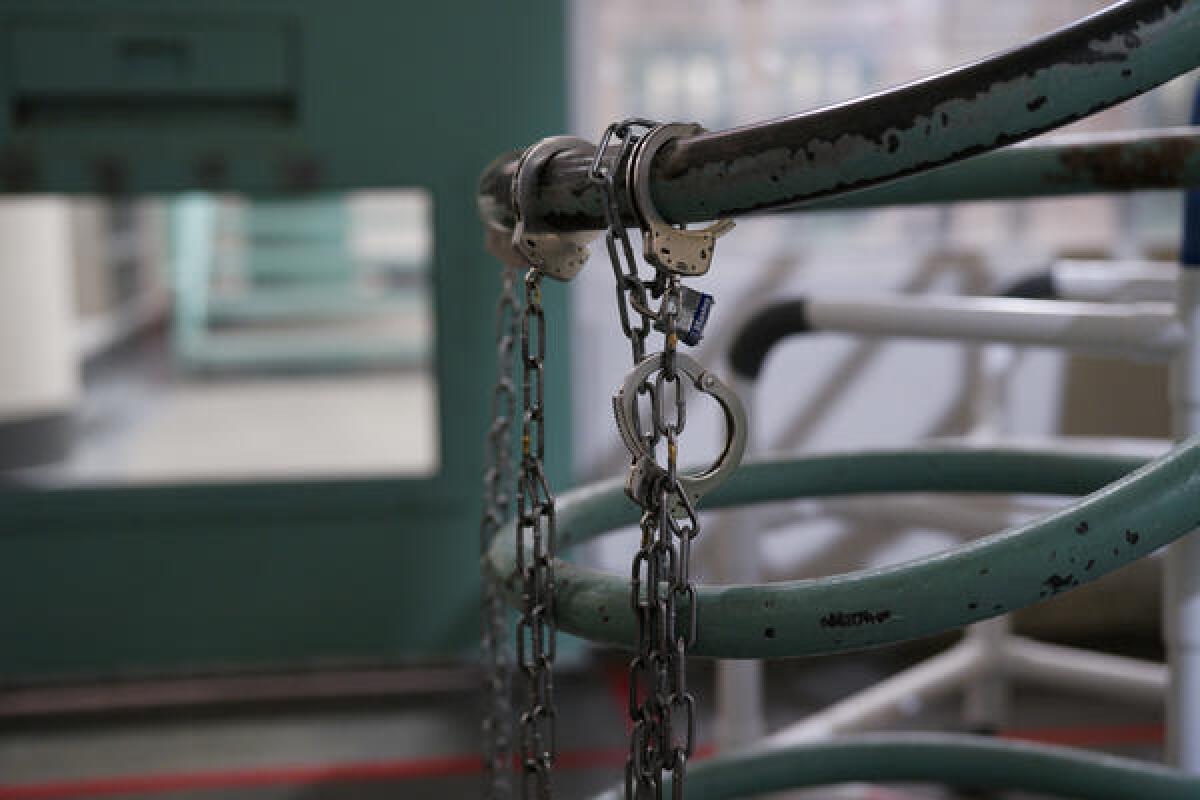San Diego politicians want to block Trump deportations. The sheriff refuses, sparking immigration battle

- Share via
A new immigration policy adopted by the San Diego County Board of Supervisors was supposed to stop jails from working with federal immigration officials, a move that would potentially hinder President-elect Donald Trump’s promise of mass deportations.
But the county is now locked in a standoff in what could be a preview of local immigration politics after Trump retakes office in January.
San Diego County Sheriff Kelly Martinez said her office won’t comply with the county’s policy and would continue to notify U.S. Immigration and Customs Enforcement officials when some people not authorized to be in the country are released from county jails.
“The Sheriff, as an independently elected official, sets the policy for the Sheriff’s Office,” the office said in a statement hours after the board approved the policy. “The Sheriff has the sole and exclusive authority to operate county jails.”
The stalemate comes as some California jurisdictions are bracing for Trump’s promise on deportations and adopting policies designed to protect immigrant communities. Some California officials, including Atty. Gen. Rob Bonta, said they are readying for legal fights against the incoming administration.
The U.S. is one of more than 30 countries with unrestricted birthright citizenship. Trump said in a recent interview that he plans to revoke the right.
The clash between the majority of San Diego County’s Board of Supervisors and its sheriff also illustrates how — even in California, a sanctuary state — efforts to undermine the Trump administration’s deportation plans could face legal challenges, practical hurdles and clashes when local officials disagree.
Martinez and the majority of the supervisors are Democrats, but local law enforcement officials sometimes have pushed back against policies that would reduce their cooperation with federal law enforcement. In San Diego, it’s unclear how county officials and the Sheriff’s Office intend to go forward.
In a statement to The Times, Martinez reiterated her decision not to follow the board policy. She declined to be interviewed.
“We do not plan to seek legal action against the County regarding the Board’s policy,” the statement said. “However, I want to assure the public that the Sheriff’s Office will continue to follow existing state law and maintain our current practices, which reflect years of experience in balancing public safety with community trust.”
Martinez also said she did not believe the current process was a burden on staff or used taxpayer money unnecessarily.

Meanwhile, a county spokesperson said the board has directed staff to draft a plan on how to effectively implement the policy. The spokesperson did not respond to questions on how the Board of Supervisors, the sheriff or county counsel would move through the impasse.
Ian Seruelo — chair of the San Diego Immigrant Rights Consortium, which worked with county officials to draft the policy — said: “We hope that [Sheriff Martinez] will reconsider and possibly consult with a legal team.”
Under state laws, local law enforcement can cooperate with ICE if someone in their jails suspected of being in the country illegally has been convicted of a serious felony — such as assault, battery, child abuse or sexual abuse, among other crimes.
The San Diego County Sheriff’s Office’s current active policy states that deputies can notify ICE when a suspected undocumented immigrant is set to be released, giving federal officers a chance to detain them.
After Joe Biden won in 2020 with less Latino support than Clinton, I warned liberals that the Democratic Party was losing blue-collar Latino men. Few listened.
San Diego County also allows ICE officials to interview people in county facilities if the suspect agrees.
But the county’s new policy would go further in restricting sheriff’s cooperation. Theoretically, jail officials would no longer notify ICE when someone is released from jail, regardless of their previous convictions, unless they have a court warrant.
Sheriff’s officials also would no longer allow ICE to interview people in the jails for immigration violations.
The policy is similar to measures adopted by Alameda, Contra Costa, Humboldt, Los Angeles, Santa Clara, San Francisco, San Joaquin and San Mateo counties.
In the statement, Martinez contended that the Board of Supervisors can’t set policy for the Sheriff’s Office. Some immigrant rights groups say that’s not the case.

Under state Senate Bill 54, also known as the California Values Act, law enforcement in the state is not allowed to use money or personnel to “detain, detect, or arrest persons for immigration enforcement purposes.” Sheriff’s and police departments also have discretion whether to cooperate with immigration officials, “only if doing so would not violate any federal, state, or local law or local policy.”
Approved in 2017, the bill was proposed during the first Trump presidency as a direct counter against the broadening deportation orders at the time.
On Thursday, the San Diego Immigrant Rights Consortium sent a letter to Martinez saying that if the sheriff ignores the new county policy, she would be in violation of SB 54.
“We hope that your statement was a mere misunderstanding on your part of the full scope of the California Values Act, and not a flagrant disregard for state law,” the letter reads. “To fully follow SB 54 and state law, you must now comply with Board Policy L-02, and we urge you to do so immediately.”
When Jim McDonnell was L.A. County sheriff, he allowed federal immigration authorities to target people for deportation in the nation’s largest jail system. Now, with Donald Trump returning to office and McDonnell set to lead the LAPD, some advocates are bracing for a fight.
Seruelo said that the latest policy was not drafted in response to Trump’s election, but that the possibility of increased deportations under a second Trump presidency made it more urgent.
“On Jan. 20 of next year, we’ll be faced with an administration that has promised to do mass deportations,” he said. “We know that it’s going to be harsh.”
County Supervisor Jim Desmond, who cast the only dissenting vote when the board approved the policy Dec. 10, said he was glad to hear of the sheriff’s opposition and criticized the vote’s timing.
“We could have done this months ago … but it came after the election,” he said.

He also contended that the policy would make immigrant communities unsafe by preventing the deportation of people convicted of serious crimes.
“A lot of people that are already living in the immigrant communities don’t want these people to come back,” he said.
He also pushed back against arguments made by some of his colleagues that immigrants would be less willing to report crimes to police if they were working with immigration officials.
President-elect Donald Trump said his plan to execute mass deportations of immigrants in the U.S. illegally will involve a national emergency declaration and the military.
But studies have confirmed fear of deportation, as well as increased cooperation between local law enforcement and immigration officials, can deter people from reporting crimes.
“Heightened immigration enforcement has the potential to reduce crime through the deportation and deterrence of immigrant offenders, but crime could increase if heightened enforcement degrades trust in law enforcement,” the Cato Institute, a public policy research organization, reported in July.
The study determined that local law enforcement’s cooperation with immigration officials increased the victimization of Latinos.
The Secure Communities program, implemented in 2013, increased collaboration between local and federal officials. Primarily, when local police made an arrest and ran a suspect’s fingerprints through the FBI’s database, the FBI then forwarded the prints to U.S. Customs and Immigration Enforcement, who would check them to identify people suspected of being undocumented.
“Contrary to the policy’s goal, of heightening enforcement to improve public safety, our analysis finds that this immigration enforcement policy increased the victimization rate of Hispanic people by 16 percent,” according to the institute.
The organization estimated that the program resulted in 1.3 additional crimes against Hispanic people in the first two years it was implemented. The rate of victimization against other non-Hispanic people seemed unchanged, except for those who lived near Hispanic communities.
For the record:
11:26 a.m. Dec. 18, 2024A previous version of this story incorrectly stated the American Civil Liberties Union helped draft the policy adopted by the San Diego County Board of Supervisors. The organization supported the policy.
Felicia Gomez, immigrant rights senior policy advocate at the American Civil Liberties Union of San Diego, which also supported the policy, said she was disappointed to see the sheriff’s action.
“San Diego has always been more than willing [to cooperate with immigration authorities] even though this collaboration is voluntary,” she said.
Statistics illustrate the level of cooperation between the San Diego Sheriff’s Office and ICE going back years. In 2023, the sheriff transferred 25 people to ICE and approved 185 requests from ICE to question jailed inmates, but also rejected 874 requests.
It also notified immigration officials about the release dates for 153 inmates — which, according to state law, local law enforcement has the discretion to do.
But the numbers were higher in previous years.
According to department data, in 2020, 78 people were transferred to ICE officials. And in 2019 and 2018, the department handed 271 and 266 people over to immigration officials, respectively.
Despite the history, Gomez said the board’s vote, as well as laws such as SB 54, are indicative that legislators in the state are looking for ways to stop local resources from being used in federal deportations.
“It’s a good sign to see our local officials pass this resolution and make a clear statement on how they want our resources utilized,” she said.
SB 54 limits how local law enforcement can work with immigration officials, Seruelo said, but immigrant rights groups are still assessing how the Trump administration tackles deportations, and how local law enforcement responds.
“We’ve been through Trump 1.0, but at that time the Trump administration was still trying to figure out how to implement, how to enforce some of its harsh policies,” he said. “In this new Trump administration, they may have learned from the past.”
More to Read
Sign up for Essential California
The most important California stories and recommendations in your inbox every morning.
You may occasionally receive promotional content from the Los Angeles Times.















